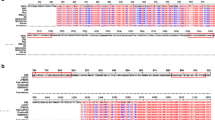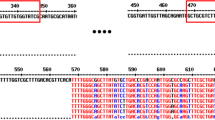Abstract
During cheese making, interactions between different strains of lactic acid bacteria play an important role. However, few methods are available to specifically determine each bacterial population in mixed cultures, in particular for strains of the same species. The aim of this study was to develop a real-time PCR quantification method to monitor the population of Lactococcus cremoris ATCC 19257 in mixed culture with Lactobacillus rhamnosus RW-9595M and the bacteriocin-producing microorganism Lc. diacetylactis UL719. The specificity of the two primers 68FCa33 and 16SR308 used to amplify a 240-bp fragment of DNA from Lc. cremoris was demonstrated by conventional PCR. Using these primers for real-time PCR, the detection limit was 2 cfu/reaction or 200 cfu of Lc. cremoris ATCC 19257 per millilitre of mixed culture in milk. In pure culture batch fermentation, good correlation was obtained between real-time PCR and the conventional plating method for monitoring Lc. cremoris growth. In mixed culture batch fermentation, Lb. rhamnosus and Lc. cremoris decreased due to nisin Z production by Lc. diacetylactis. The decrease of the Lc. cremoris cell population detected by real-time PCR was not possible to observe by the plate count method in the presence of a Lc. diacetylactis population that was 1 log higher.




Similar content being viewed by others
References
Akerlund T, Nordström K, Bernander R (1995) Analysis of cell size and DNA content in exponentially growing and stationary-phase batch cultures of Escherichia coli. J Bacteriol 177:6791–6797
Arezi B, Xing W, Sorge JA, Hogrefe HH (2003) Amplification efficiency of thermostable DNA polymerases. Anal Biochem 321:226–235. DOI 10.1016/S0003-2697(03)00465-2
Benech RO, Kheadr EE, Lacroix C, Fliss I (2002a) Antibacterial activities of nisin Z encapsulated in liposomes or produced in situ by mixed culture during cheddar cheese ripening. Appl Environ Microbiol 68:5607–5619. DOI 10.1128/AEM.68.11.5607-5619.2002
Benech RO, Kheadr EE, Laridi R, Lacroix C, Fliss I (2002b) Inhibition of Listeria innocua in cheddar cheese by addition of nisin Z in liposomes or by in situ production in mixed culture. Appl Environ Microbiol 68:3683–3690. DOI 10.1128/AEM.68.8.3683-3690.2002
Benech RO, Kheadr EE, Lacroix C, Fliss I (2003) Impact of nisin producing culture and liposome-encapsulated nisin on ripening of Lactobacillus added-Cheddar cheese. J Dairy Sci 86:1895–1909
Bergmaier D, Lacroix C, Macedo MG, Champagne CP (2001) New method for exopolysaccharide determination in culture using stirred ultrafiltration cells. Appl Microbiol Biotechnol 57:401–406. DOI 10.1007/s002530100764
Cerning J (1990) Exocellular polysaccharides produced by lactic acid bacteria. FEMS Microbiol Rev 87:113–130
Cleveland J, Montville TJ, Nes IF, Chikindas ML (2001) Bacteriocins: safe, natural antimicrobials for food preservation. Int J Food Microbiol 71:1–20. DOI 10.1016/S0168-1605(01)00560-8
Delves-Broughton J, Blackburn P, Evans RJ, Hugenholtz J (1996) Applications of the bacteriocin, nisin. Antonie Van Leeuwenhoek 69:193–202
De Medici D, Croci L, Delibato E, Di Pasquale S, Filetici E, Toti L (2003) Evaluation of DNA extraction methods for use in combination with SYBR Green I real-time PCR to detect Salmonella enterica serotype enteritidis in poultry. Appl Environ Microbiol 69:3456–3461. DOI 10.1128/AEM.69.6.3456-3461.2003
Duboc P, Mollet B (2001) Applications of exopolysaccharides in the dairy industry. Int Dairy J 11:759–768. DOI 10.1016/S0958-6946(01)00119-4
Even S, Lindley ND, Loubière P, Cocaign-Bousquet M (2002) Dynamic response of catabolic pathways to autoacidification in Lactococcus lactis: transcript profiling and stability in relation to metabolic and energetic constraints. Mol Microbiol 45:1143–1152. DOI 10.1046/j.1365-2958.2002.03086.x
Fowler GG, Jarvis B, Tramer J (1975) The assay of nisin in foods. Soc Appl Bacteriol Tech Ser 8:91–105
Hein I, Lehner A, Rieck P, Klein K, Brandl E, Wagner M (2001) Comparison of different approaches to quantify Staphylococcus aureus cells by real-time quantitative PCR and application of this technique for examination of cheese. Appl Environ Microbiol 67:3122–3126. DOI 10.1128/AEM.67.7.3122-3126.2001
Kempler GM, McKay LL (1980) Improved medium for detection of citrate fermenting Streptococcus lactis ssp. diacetylactis. Appl Environ Microbiol 4:926–927
Klaenhammer TR (1993) Genetics of bacteriocins produced by lactic acid bacteria. FEMS Microbiol Rev 12:39–86
McAuliffe O, Ross RP, Hill C (2001) Lantibiotics: structure, biosynthesis and mode of action. FEMS Microbiol Rev 25:285–308. DOI 10.1016/S0168-6445(00)00065-6
Meghrous J, Lacroix C, Bouksaim M, Lapointe G, Simard RE (1997) Genetic and biochemical characterization of nisin Z produced by Lactococcus lactis ssp. lactis biovar diacetylactis UL719. J Appl Microbiol 83:133–138. DOI 10.1046/j.1365-2672.1997.00160.x
Morillo JM, Lau L, Sanz M, Herrera D, Silva A (2003) Quantitative real-time PCR based on single copy gene sequence for detection of Actinobacillus actinomycetemcomitans and Porphyromonas gingivalis. J Periodontal Res 38:518–524. DOI 10.1034/j.1600-0765.2003.00684.x
Newby DT, Hadfield TL, Roberto FF (2003) Real-time PCR detection of Brucella abortus: a comparative study of SYBR Green I, 5′ exonuclease, and hybridization probe assays. Appl Environ Microbiol 69:4753–4759. DOI 10.1128/AEM.69.8.4753-4759.2003
Nogva HK, Rudi K, Naterstad K, Holck A, Lillehaug D (2000) Application of 5′-nuclease PCR for quantitative detection of Listeria monocytogenes in pure cultures, water, skim milk, and unpasteurized whole milk. Appl Environ Microbiol 66:4266–4271
Rudi K, Nogva HK, Moen B, Nissen H, Bredholt S, Moretro T, Naterstad K, Holck A (2002) Development and application of new nucleic acid-based technologies for microbial community analyses in foods. Int J Food Microbiol 78:171–180. DOI 10.1016/S0168-1605(02)00236-2
Salama M, Sandine W, Giovannoni S (1991) Development and application of oligonucleotide probes for identification of Lactococcus lactis subsp. cremoris. Appl Environ Microbiol 57:1313–1318
Sallami L, Kheadr EE, Fliss I, Vuillemard JC (2004) Impact of autolytic and proteolytic lactobacilli and nisin-producing culture on proteolysis and sensory characteristics in cheddar cheese. J Food Sci 69:24–32
Stubner S (2002) Enumeration of 16S rDNA of Desulfotomaculum lineage 1 in rice field soil by real-time PCR with SybrGreen detection. J Microbiol Methods 50:155–164. DOI 10.1016/S0167-7012(02)00024-6
Tagg JR, Dajani AS, Wannamaker LW (1976) Bacteriocins of gram-positive bacteria. Bacteriol Rev 40:722–756
Theron J, Cloete TE (2000) Molecular techniques for determining microbial diversity and community structure in natural environments. Crit Rev Microbiol 26:37–57
Urbach E, Daniels B, Salama MS, Sandine WE, Giovannoni SJ (1997) The ldh phylogeny for environmental isolates of Lactococcus lactis is consistent with rRNA genotypes but not with phenotypes. Appl Environ Microbiol 63:694–702
United States Food and Drug Administration (1988) Nisin preparation: affirmation of GRAS status as direct human food ingredient. Federal register 53, April 6
Acknowledgements
The authors wish to thank the Natural Sciences and Engineering Research Council of Canada (Research Partnerships Program—Research Network on Lactic Acid Bacteria), Agriculture and Agri-Food Canada, Novalait, Inc., Dairy Farmers of Canada and Institut Rosell, Inc. for financial support.
Author information
Authors and Affiliations
Corresponding author
Additional information
An erratum to this article can be found at http://dx.doi.org/10.1007/s00253-004-1822-0
Rights and permissions
About this article
Cite this article
Grattepanche, F., Lacroix, C., Audet, P. et al. Quantification by real-time PCR of Lactococcus lactis subsp. cremoris in milk fermented by a mixed culture. Appl Microbiol Biotechnol 66, 414–421 (2005). https://doi.org/10.1007/s00253-004-1705-4
Received:
Revised:
Accepted:
Published:
Issue Date:
DOI: https://doi.org/10.1007/s00253-004-1705-4




